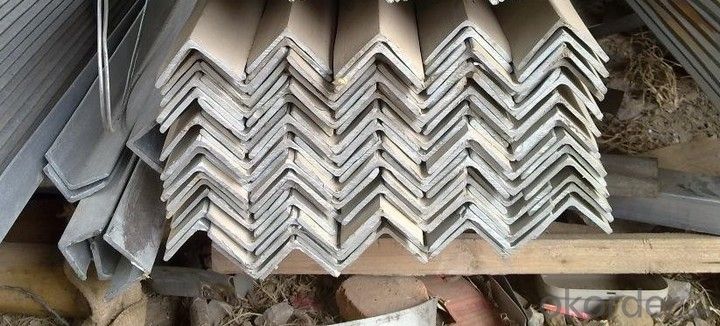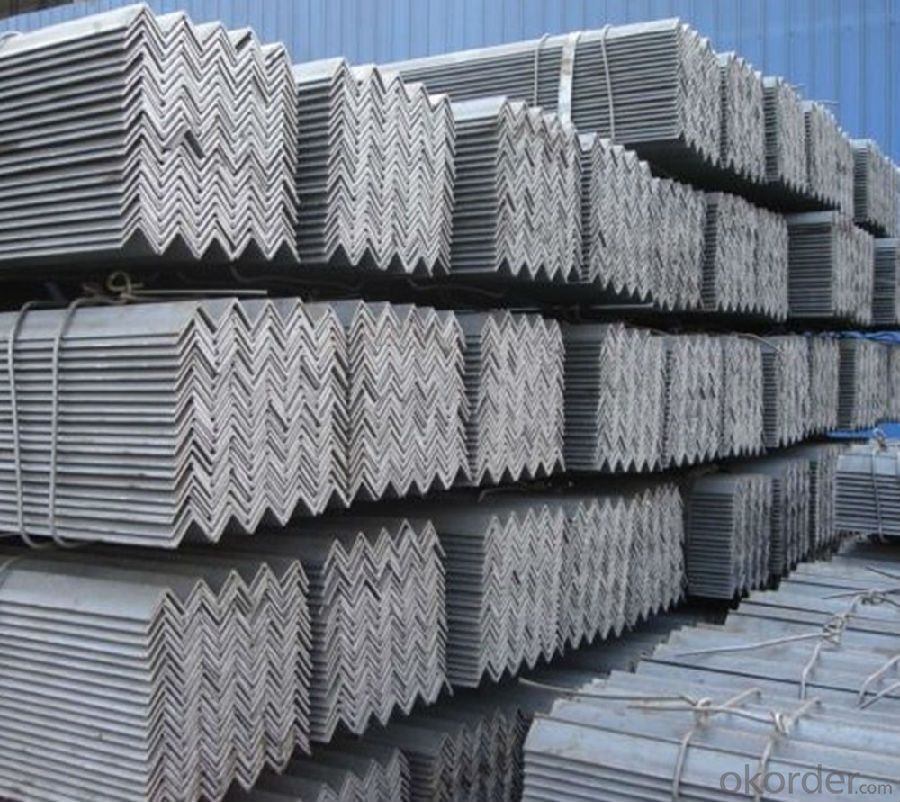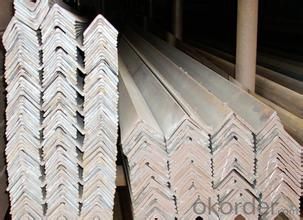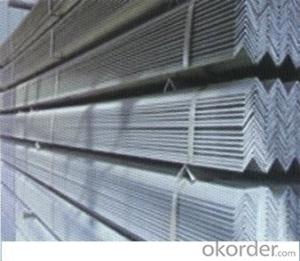GB Q235B galvanized angle steel for construction
- Loading Port:
- Tianjin
- Payment Terms:
- TT OR LC
- Min Order Qty:
- 25 m.t.
- Supply Capability:
- 10000 m.t./month
OKorder Service Pledge
OKorder Financial Service
You Might Also Like
Product Description:
ASTM 316l Stainless Angle Steel Bar
1.Surface:Bright,Polished,Turn smooth(Peeled),Brush,Mill,Pickled
2.Length:3m, 6m,9m,12m
3.Use:These products are widely supplied to areas of machine-made industry,chemical industry,spin,shipping industry,architecture,food industry,household products etc
4 ISO9001:2008
SPECIFICATION
Standard | AISI, ASTM, BS, DIN, GB, JIS, etc |
Grade | Q195, Q215, Q235, Q345, SS400, A36, S235JR, ST37, etc |
Technical parameters:
1) Material: Q235B , Q 345B, SS400 ,SS540, S235JR ,ETC. | |||
| 2) Usage: structure construction and electronic tower building | |||
| 3) Weight tolarance: -4% TO -10% | |||
| 4) Size tolarance : | |||
| ANGLE STEEL SIstructural steel angleE TOLARANCE (MM) | |||
| SIstructural steel angleE cm | WIDTH b/mm | THICKNESS d/mm | LENGTH /m |
| 2-5.6 | +/-0.8 | +/-0.4 | 4-12 |
| 6.3-9 | +/-1.2 | +/-0.6 | 4-12 |
| 10-14 | +/-1.8 | +/-0.7 | 4-12 |
| 16-20 | +/-2.5 | +/-1.0 | 4-12 |
| 5) Payment terms: TT or LC | |||
| 6) Delivery date: within 30 days after receiving the LC or TT prepay | |||
| 7) Packing: Export package | |||
| 8) Inspection: accept third party inspection | |||
Other Steel Bar Specification:
1.Square bar:Size: 4mm*4mm~100mm*100mm
2.Round Bar:Diameter: 3mm~800mm
3.Angel Bar:Size: 3mm*20mm*20mm~12mm*100mm*100mm
4.Flat bar:Thickness: 2mm~100mm,Width: 10mm~500mm,
5.Hexagonal :Size: 2mm~100mm



- Q:What are the common loadings or forces that steel angles are designed to withstand?
- Steel angles are designed to withstand common loadings or forces such as axial compression, axial tension, bending, shear, and torsion.
- Q:Are steel angles suitable for architectural sculptures or installations?
- Yes, steel angles can be suitable for architectural sculptures or installations. Steel angles are versatile and durable, making them a popular choice for creating intricate and visually appealing structures. Their geometric shape allows for interesting angles and shapes to be formed, adding a unique aesthetic to architectural sculptures or installations. Additionally, steel angles can be easily welded or attached together, providing flexibility in design and construction. The strength and stability of steel angles also make them suitable for outdoor installations, as they can withstand various weather conditions. Overall, steel angles offer architects and artists a reliable and versatile material to create innovative and striking sculptures or installations.
- Q:What are the different types of steel angles connections for trusses?
- There are several types of steel angle connections commonly used for trusses, including gusset plate connections, bolted connections, welded connections, and clip angles.
- Q:How do you determine the strength of a steel angle?
- The strength of a steel angle can be determined by several factors, including its material composition, size, and shape. First, the material composition of the steel angle is crucial in determining its strength. Steel angles are typically made from various alloys, such as carbon steel or stainless steel, which have different strength properties. The specific grade or type of steel used will affect its strength, with higher-grade steels generally having greater strength. Second, the size of the steel angle plays a significant role in determining its strength. The dimensions of the angle, including its length, width, and thickness, directly impact its load-bearing capacity. Generally, larger and thicker steel angles are capable of withstanding higher loads and forces. Lastly, the shape of the steel angle also influences its strength. Commonly, steel angles come in L-shapes, where the two legs are perpendicular to each other. The length and angle of the legs can affect the strength of the angle. For example, longer legs or a steeper angle between the legs can increase the strength and load-bearing capacity of the steel angle. To determine the precise strength of a steel angle, engineering calculations and analysis are typically performed. These calculations involve considering the material properties, dimensions, and loading conditions to determine the maximum load or stress the angle can withstand without failure. Additionally, industry standards and codes, such as those set by organizations like the American Society for Testing and Materials (ASTM) or the American Institute of Steel Construction (AISC), provide guidelines and specifications for determining the strength of steel angles.
- Q:What does L50*4 angle mean in CAD?
- Angle called angle, the steel strip is perpendicular to each other on both sides into the corner. There are equal angles and unequal angles. The two sides of an equal angle steel are equal in width. The specifications are expressed in millimeters of edge width * edge width * edge thickness. Such as "30 x 30 x 3", that is 30 mm width equal angle, edge thickness of 3 mm.
- Q:What are the properties of steel angles?
- Steel angles have several properties that make them highly versatile and widely used in various industries. Firstly, they have excellent strength-to-weight ratio, providing structural stability and support. Secondly, steel angles offer great resistance to corrosion and impact, ensuring durability in different environments. Additionally, they have high malleability and ductility, allowing for easy fabrication and shaping to meet specific design requirements. Lastly, steel angles possess good thermal conductivity and are fire-resistant, making them suitable for applications where heat transfer and fire protection are crucial.
- Q:Are steel angles suitable for manufacturing support brackets for cables?
- Yes, steel angles are suitable for manufacturing support brackets for cables. Steel angles provide strength and durability, making them an ideal choice for supporting and securing cables in various applications. They offer stability and can be easily customized and fabricated to meet specific requirements, ensuring reliable support for cable systems.
- Q:What are the different types of steel angles used in door and window frames?
- There are several types of steel angles commonly used in door and window frames, each offering unique benefits and applications. 1. L-shaped Angle: This is the most common type of steel angle used in door and window frames. It features a 90-degree angle and is typically used to provide structural support and reinforcement. L-shaped angles are versatile and can be easily welded or bolted into place, making them suitable for various frame designs. 2. T-shaped Angle: As the name suggests, T-shaped angles have a cross-section resembling the letter "T." They are often used to provide additional strength and stability to door and window frames. T-shaped angles are commonly used in heavy-duty applications where increased load-bearing capacity is required. 3. Equal Angle: Equal angles have two equal sides that form a 90-degree angle. They are commonly used in door and window frames that require equal support on both sides. These angles are suitable for applications where symmetry and balance are important, ensuring that the frame remains stable and level. 4. Unequal Angle: Unlike equal angles, unequal angles have two sides of different lengths. They are commonly used in door and window frames that require varying degrees of support on each side. Unequal angles are versatile and can be used to compensate for differences in wall thickness or other structural considerations. 5. Slotted Angle: Slotted angles are often used in door and window frames that require adjustable or modular designs. They feature a series of holes or slots along their length, allowing for easy attachment and customization. Slotted angles are commonly used in DIY projects or applications where flexibility and adjustability are desired. It is worth noting that the choice of steel angle for door and window frames depends on various factors such as the specific application, load-bearing requirements, and aesthetic considerations. Consulting with a structural engineer or a professional in the field can help determine the most suitable type of steel angle for a particular project.
- Q:Are steel angles resistant to extreme weather conditions?
- Yes, steel angles are highly resistant to extreme weather conditions. They have excellent durability and can withstand harsh weather elements such as heavy rain, strong winds, and extreme temperatures without any significant damage or deterioration.
- Q:How do steel angles contribute to the overall aesthetics of a building?
- There are several ways in which steel angles can enhance the aesthetics of a building. First and foremost, their sleek and clean lines can give a contemporary touch to the structure, adding a sense of modern style. Moreover, the angular shape of steel angles can create captivating patterns and forms, bringing depth and dimension to the building's exterior. Additionally, architects can creatively employ steel angles to accentuate architectural features and introduce unique design elements. They can be integrated into the building's façade or used as decorative elements to draw attention to specific areas and generate visual interest. For instance, steel angles can be used to frame windows or doors, establishing a striking contrast with the surrounding materials. In combination with materials like glass or concrete, steel angles can also produce interesting shadows and reflections. This interplay of light and shadow imparts a dynamic and ever-changing quality to the building's appearance, resulting in a visually captivating effect. Furthermore, steel angles offer remarkable versatility and can be easily tailored to meet the specific design requirements of a building. They can be cut, bent, and welded into various shapes and sizes, enabling architects and designers to explore limitless possibilities in terms of form and composition. This design flexibility allows for the creation of unique structures that are visually appealing and stand out from the rest. In conclusion, steel angles play a pivotal role in enhancing the overall aesthetics of a building by providing a sleek and modern look, generating visually captivating patterns and forms, accentuating architectural features, creating intriguing shadows and reflections, as well as offering endless design possibilities. Their versatility and customization options make them an invaluable tool for architects and designers in creating visually captivating and aesthetically pleasing buildings.
1. Manufacturer Overview |
|
|---|---|
| Location | |
| Year Established | |
| Annual Output Value | |
| Main Markets | |
| Company Certifications | |
2. Manufacturer Certificates |
|
|---|---|
| a) Certification Name | |
| Range | |
| Reference | |
| Validity Period | |
3. Manufacturer Capability |
|
|---|---|
| a)Trade Capacity | |
| Nearest Port | |
| Export Percentage | |
| No.of Employees in Trade Department | |
| Language Spoken: | |
| b)Factory Information | |
| Factory Size: | |
| No. of Production Lines | |
| Contract Manufacturing | |
| Product Price Range | |
Send your message to us
GB Q235B galvanized angle steel for construction
- Loading Port:
- Tianjin
- Payment Terms:
- TT OR LC
- Min Order Qty:
- 25 m.t.
- Supply Capability:
- 10000 m.t./month
OKorder Service Pledge
OKorder Financial Service
Similar products
New products
Hot products
Related keywords



























